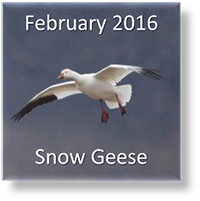
The snow goose (Anser caerulescens) is a large waterfowl species. It is typically 25 inches to 38 inches in length. Three toes on each foot are webbed. Its bill is flattened with a toothlike fringe along the edge to allow it to strain food from the water. It eats aquatic plants and seeds. Its call is a "yelp" or "whouk" sound.
The name "snow goose" was given to these birds because when they are feeding in a field, there can be so many of them that at a distance, the ground appears to be covered with snow. When you get closer, though, you find that not all snow geese are white.
Snow geese are also known as "blue geese" for there are three types of coloration in snow geese. The white-phase snow geese have white feathers except for their flight feathers, and those are black. These birds have a pink bill, pink feet and orange-red patches on the head. The blue-phase snow geese have blue-gray feathers, a white head, a pink bill and pink feet. There are also mixed blue- and white-phase snow geese that show both types of feathers. Young snow geese are similar in color to the white-phase birds, but their feathers are darker and the bill is dark.
Snow geese in Illinois can be found near water, on lakes and rivers and in fields where grain has been harvested. They fly in a large, irregular mass or a sort of "U" shape. It is very different from the "V" shape shown by Canada geese (Branta canadensis) in flight. Seeing a massive number of snow geese in flight or on the ground is an impressive experience!
Snow geese start moving though Illinois in late January or February on their way to the nesting grounds in the Arctic tundra. They winter as far south as the western coast of the Gulf of Mexico, although some of these birds stay in Illinois all winter, too. The fall migrants begin returning to Illinois in mid-October.
At the start of the twentieth century, the population of snow geese in North America was in decline. Since the 1970s, though, the number of breeding snow geese has increased tremendously, by more than 300 percent. There are so many snow geese in the Arctic breeding grounds and the southern wintering grounds that they are destroying habitat and affecting other species. Special hunting seasons have been established to help control the population of these birds.
Youth in Illinois have the opportunity to experience hunting snow geese through the Illinois Department of Natural Resources’ (IDNR) Youth Waterfowl Hunts as well as through the regular hunting season for this species and the Conservation Order Light Goose Seasons. Learn more about the season dates and regulations through the IDNR’s Digest of Waterfowl Regulations. You can download this publication from the
publications Web site or the
IDNR Home Page.

